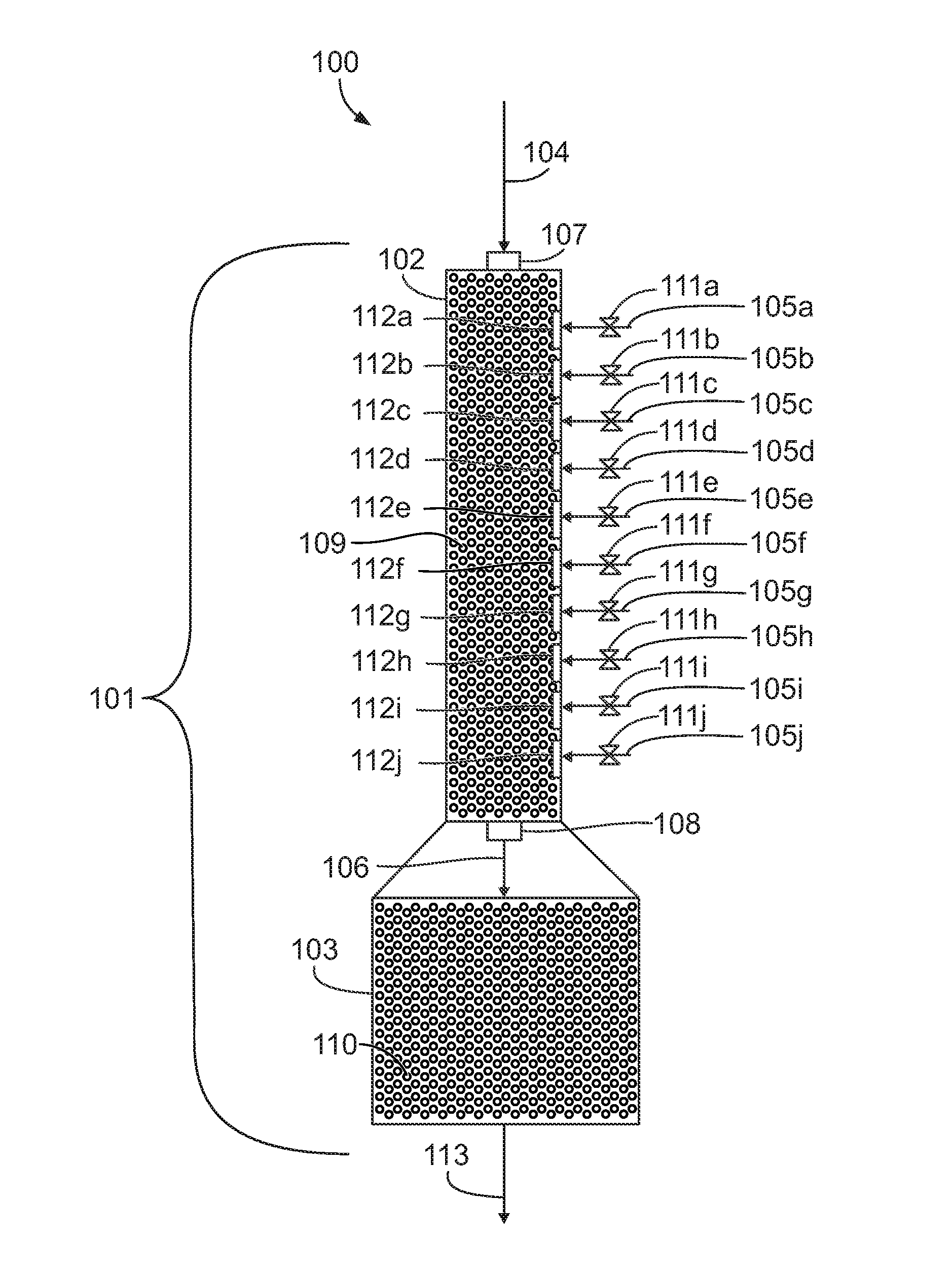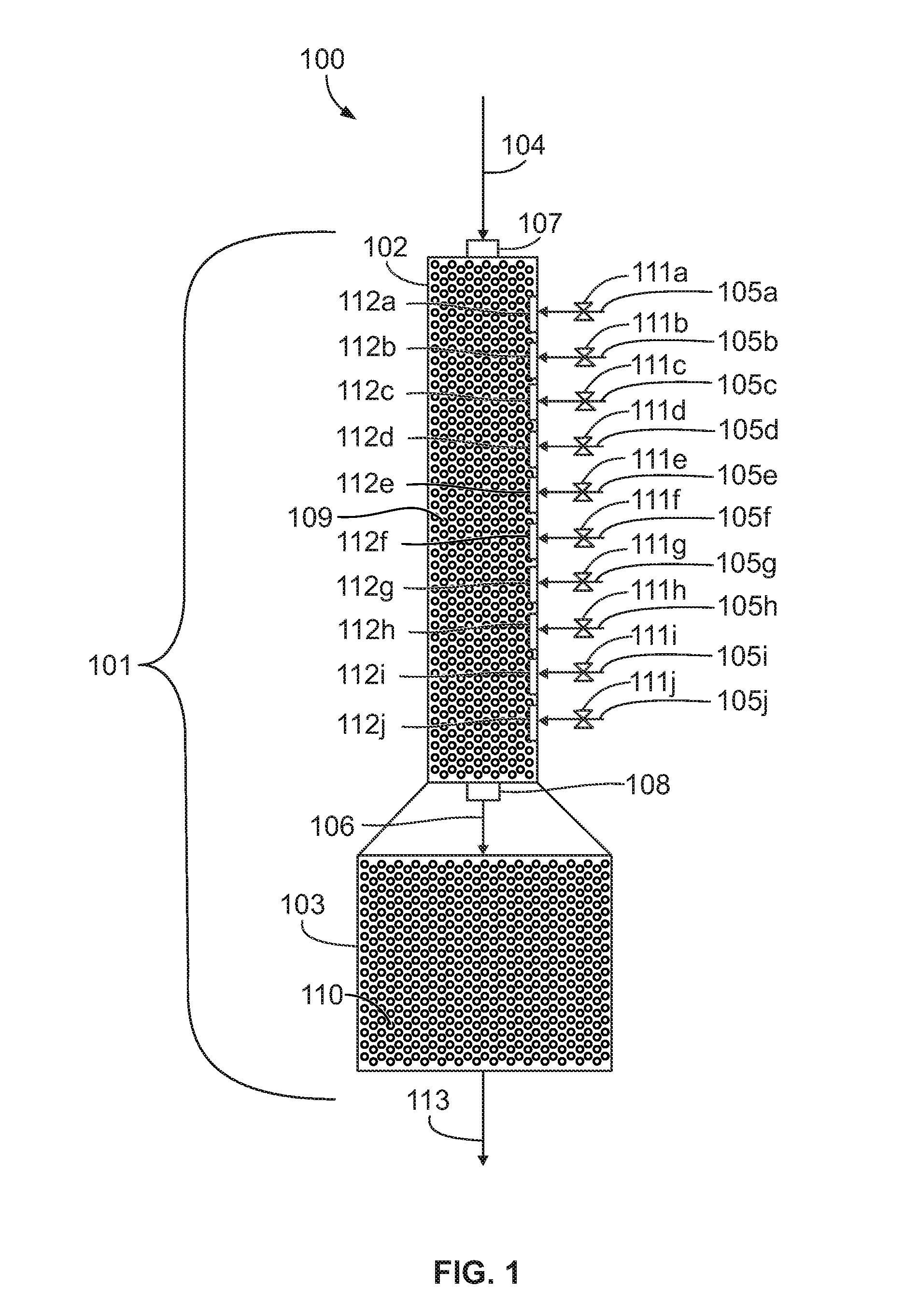Isothermal reactor for hydrocarbon nitration
a technology of hydrocarbon nitration and isothermal reactor, which is applied in the preparation of nitric acid ester, chemical/physical/physicochemical processes, organic chemistry, etc., can solve the problems of temperature control, corrosion, potential mixing, and high capital expenditure of downstream separation processes
- Summary
- Abstract
- Description
- Claims
- Application Information
AI Technical Summary
Benefits of technology
Problems solved by technology
Method used
Image
Examples
example 1
Effect of Multiple Input Ports on Temperature Rise Using 30 Weight Percent Nitric Acid
[0035]Propane and acetic acid are reacted with 30 weight percent aqueous nitric acid at a reaction temperature of 180 degrees Celsius, a reactor pressure of 1300 psi (87 atm), a residence time of about 120 seconds, and a propane to nitric acid mole ratio of about 1.4:1. The aqueous nitric acid feed is split evenly between ten input ports. Additional aqueous nitric acid is added at 30 degrees Celsius. The feed rates are shown in Table 1.
TABLE 1Feed rates for reaction using reactor with multiple input portsComponentFeed RatePropane147 lb / hrAcetic acid243 lb / hrNitric acid (total)150 lb / hrWater (total)350 lb / hr
[0036]Table 2 shows a comparison of temperatures for the above nitration reaction using a reactor with ten input ports with the same reaction using a reactor with only one input port.
TABLE 2Comparison of temperatures for the reaction usingreactor with multiple input ports to the temperaturesusing...
example 2
Effect of Multiple Input Ports on Temperature Rise Using 64 Weight Percent Nitric Acid
[0039]Propane and acetic acid are reacted with 64 weight percent aqueous nitric acid at a reaction temperature of 180 degrees Celsius, a reactor pressure of 1300 psi (87 atm), a residence time of about 120 seconds, and a propane to nitric acid mole ratio of about 1.4:1. The aqueous nitric acid feed is split evenly between ten input ports. Additional aqueous nitric acid is added at 30 degrees Celsius. The feed rates are shown in Table 4.
TABLE 4Feed rates for reaction using reactor with multiple input portsComponentFeed RatePropane147 lb / hrAcetic acid243 lb / hrNitric acid (total)150 lb / hrWater (total) 85 lb / hr
[0040]This example shows the effect of using higher strength nitric acid. It is believed that it is beneficial to balance the heat of reaction with the heat of vaporization of reactants. As described below, Example 2 suggests that using 64 weight percent aqueous nitric acid does not satisfy this ...
example 3
Nitration of Propane at 180° C.
[0045]Propane and acetic acid are reacted in the above-described reactor with 30 weight percent aqueous nitric acid at reaction temperature of 180 degrees Celsius, a reactor pressure of 1400 psi (96.7 atm), and a residence time of 105 seconds (based on the volume of the reactor divided by the flow rate of the feeds at room temperature and 1400 psi). The propane to nitric acid mole ratio is about 1.9:1. The feed composition and the reaction product composition are summarized in Table 7 below.
TABLE 7Feed composition and reaction product compositionfor the nitration of propane at 180° C.ComponentFeed (g)Reaction Product (g)Propane562436Nitric Acid4241.5Water182276Acetic Acid806888Acetone014.0Nitromethane016.9Nitroethane01.12-Nitropropane01731-Nitropropane020.92,2-Dinitropropane02.7Nitric Oxide040.0Nitrous Oxide07.6Nitrogen015.0Carbon Monoxide09.7Carbon Dioxide036.5
[0046]Key performance metrics for this reaction are summarized in Table 8.
TABLE 8Key perform...
PUM
| Property | Measurement | Unit |
|---|---|---|
| temperature | aaaaa | aaaaa |
| temperature | aaaaa | aaaaa |
| temperature | aaaaa | aaaaa |
Abstract
Description
Claims
Application Information
 Login to View More
Login to View More - R&D
- Intellectual Property
- Life Sciences
- Materials
- Tech Scout
- Unparalleled Data Quality
- Higher Quality Content
- 60% Fewer Hallucinations
Browse by: Latest US Patents, China's latest patents, Technical Efficacy Thesaurus, Application Domain, Technology Topic, Popular Technical Reports.
© 2025 PatSnap. All rights reserved.Legal|Privacy policy|Modern Slavery Act Transparency Statement|Sitemap|About US| Contact US: help@patsnap.com


